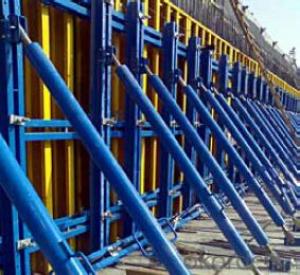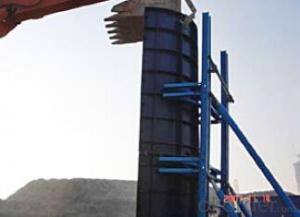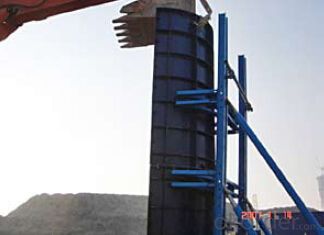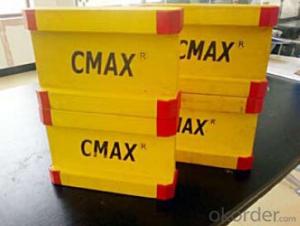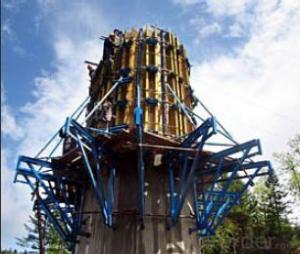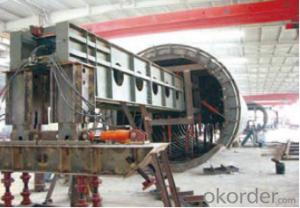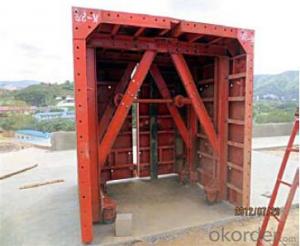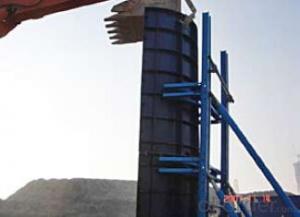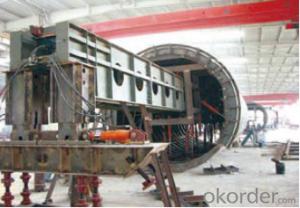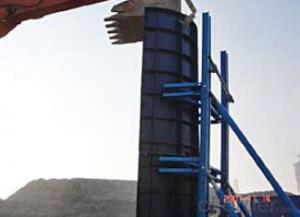Tunnel formwork system and scaffolding system
- Loading Port:
- Tianjin
- Payment Terms:
- TT OR LC
- Min Order Qty:
- 50 m²
- Supply Capability:
- 1000 m²/month
OKorder Service Pledge
Quality Product, Order Online Tracking, Timely Delivery
OKorder Financial Service
Credit Rating, Credit Services, Credit Purchasing
You Might Also Like
Building Bridge&Tunnel Formwork:
A compositional steel formwork system mainly used in the building which has regular structure
without beams, the excellent formwork system can make the integral pouring for the wall & slab
easily achieved.
Characteristics:
◆ No assembling, easy operation with formed formwork.
◆ High stiffness, make perfect shape for concrete.
◆ Repeatedly turnover is available.
◆ Widely applied range, such as building, bridge, tunnel, etc.
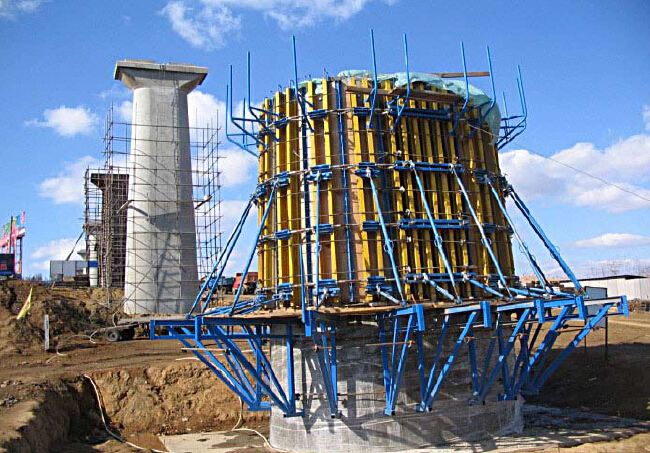
- Q: What are the different types of reinforcement systems used with steel formwork?
- There are several different types of reinforcement systems that are commonly used with steel formwork in construction projects. These systems are designed to provide additional strength and stability to the formwork, ensuring that it can withstand the weight of the concrete and other loads. One common type of reinforcement system is the use of steel bars or rods, also known as rebar. Rebar is typically placed horizontally and vertically within the formwork to create a grid-like structure. This helps to distribute the weight of the concrete evenly and prevent any potential cracks or failures in the formwork. Another type of reinforcement system is the use of wire mesh or welded wire fabric. This is a grid of wires that is typically laid over the formwork before the concrete is poured. The wire mesh helps to reinforce the concrete and provide additional strength and durability. In some cases, steel formwork may also incorporate precast concrete elements as reinforcement. These elements, such as precast beams or columns, are placed within the formwork to provide additional support and reinforcement to the structure. Additionally, some formwork systems may utilize post-tensioning techniques for reinforcement. This involves installing steel cables or bars within the formwork and then applying tension to them after the concrete has been poured. This helps to increase the strength and stability of the formwork and the overall structure. Overall, the choice of reinforcement system will depend on the specific requirements of the project, including the load capacity, design specifications, and desired level of durability. By using appropriate reinforcement systems, steel formwork can be made stronger and more reliable, ensuring the success and safety of the construction project.
- Q: What are the weight limits for steel formwork panels?
- The weight limits for steel formwork panels can vary depending on several factors such as the thickness and dimensions of the panel, the type of steel used, and the specific design and construction requirements of the project. Generally, steel formwork panels are designed to withstand heavy loads and provide structural support during concrete pouring and curing processes. However, it is important to consult the manufacturer or supplier of the steel formwork panels for specific weight limits and load-bearing capacities. They can provide detailed technical specifications and guidelines to ensure the safe and efficient use of the panels on construction sites.
- Q: How does steel formwork affect the schedule of concrete pouring?
- The schedule of concrete pouring can be significantly influenced by steel formwork. A major advantage of using steel formwork is its strength and durability, which enables faster construction progress. Unlike traditional wooden formwork, steel formwork can be reused multiple times, resulting in shorter construction cycles and faster completion times. Moreover, the use of steel formwork facilitates a quicker assembly and disassembly process. It requires less time to set up compared to wooden formwork since it usually comes prefabricated or in standard sizes that can be easily assembled on site. This speedy assembly process reduces the time required for formwork installation, initiating concrete pouring sooner. Additionally, steel formwork provides a smooth and uniform surface finish to the concrete. This eliminates the need for plastering or additional finishing work, saving time and effort. The smooth surface also reduces the curing time of the concrete, as it allows for more efficient evaporation of moisture. Furthermore, steel formwork is renowned for its superior strength and stability. This allows for a higher rate of concrete pouring, as it can withstand the pressure exerted by the wet concrete without deforming or collapsing. With steel formwork, larger concrete sections can be poured simultaneously, reducing the number of pours and thus saving time. Nevertheless, it is crucial to note that careful planning and coordination are required for steel formwork to ensure a seamless workflow. The availability of steel formwork materials and equipment, as well as skilled labor, must be considered during the project scheduling process. Any delays in the procurement or fabrication of steel formwork can impact the schedule for concrete pouring. In conclusion, steel formwork positively impacts the schedule of concrete pouring by reducing construction time, providing a smooth surface finish, allowing for faster assembly and disassembly, and enabling the pouring of larger concrete sections at once. However, proper planning and coordination are crucial to maximize the benefits of steel formwork and avoid potential delays.
- Q: Can steel formwork be used for both thin and thick concrete elements?
- Yes, steel formwork can be used for both thin and thick concrete elements. Steel formwork is versatile and can be easily adjusted or modified to accommodate different thicknesses of concrete. It provides strength and stability, making it suitable for various construction projects, such as walls, columns, beams, slabs, and even complex architectural structures. Steel formwork also offers a smooth and precise finish to the concrete, ensuring high-quality results. Additionally, steel formwork is durable and can be reused multiple times, making it a cost-effective choice for both thin and thick concrete elements.
- Q: How does steel formwork affect construction speed and efficiency?
- There are several ways in which the use of steel formwork can greatly improve the speed and efficiency of construction. To begin with, steel formwork is extremely durable and can withstand repeated use, which reduces the need for replacing or repairing materials. This saves both time and money by preventing delays caused by damage or deterioration of the formwork. Furthermore, steel formwork ensures a high level of accuracy and precision during construction. Its strong structure guarantees consistent dimensions and alignment, resulting in uniform concrete placement and minimizing the need for adjustments. This saves time and effort, allowing construction teams to work more efficiently and complete projects on schedule. Moreover, steel formwork is highly versatile and adaptable. It can easily be customized to fit various shapes and sizes, making it ideal for constructing complex structures. This eliminates the need for extensive manual cutting or modification of materials, saving both time and labor. Additionally, steel formwork offers a quick and easy assembly and dismantling process. Its modular design allows for simple installation and removal, reducing the time required for preparation and cleanup. This not only speeds up construction progress but also minimizes downtime between different stages of the project. Lastly, steel formwork has an excellent load-bearing capacity. Its sturdy construction can support heavy concrete loads, allowing for larger pours and reducing the number of breaks needed. This increases the productivity of the construction team, as they can complete larger sections of the structure in a shorter amount of time. In conclusion, the use of steel formwork significantly improves construction speed and efficiency by providing durability, accuracy, versatility, quick assembly, and load-bearing capabilities. Its ability to reduce construction time, minimize errors, and optimize resource utilization makes it a preferred choice for many construction projects.
- Q: What are the different types of edge protections available for steel formwork?
- There are several types of edge protections available for steel formwork, each serving a specific purpose and providing different levels of safety and functionality. Some of the common types include: 1. Steel edge protection: This type of edge protection is made of steel and is typically used in heavy-duty construction projects. It provides excellent durability and strength, ensuring the safety of workers and preventing accidental falls. 2. Rubber edge protection: Rubber edge protection is a flexible and lightweight option that offers impact resistance and a cushioning effect. It is commonly used in areas where workers may come into contact with the edge, such as staircases or walkways. 3. Plastic edge protection: Plastic edge protection is lightweight, easy to install, and cost-effective. It provides a barrier between workers and the edge, preventing accidental slips or falls. Plastic edge protection is commonly used in low-risk areas or temporary construction sites. 4. Foam edge protection: Foam edge protection is made of soft and flexible material, providing a cushioning effect and preventing injury if someone accidentally bumps into it. It is typically used in areas where there is less risk of falls but a higher chance of impact. 5. Metal edge protection: Metal edge protection is commonly used in industrial settings where heavy machinery or equipment may come into contact with the edge. It offers excellent durability and protection against impact, ensuring the safety of both workers and equipment. 6. Removable edge protection: This type of edge protection can be easily installed and removed when no longer needed. It is commonly used in areas where temporary edge protection is required, such as during construction or renovation projects. It is essential to choose the appropriate type of edge protection based on the specific requirements of the construction project, considering factors such as the level of risk, durability, ease of installation, and cost-effectiveness.
- Q: What are the common connection methods for steel formwork?
- Steel formwork can be connected using several common methods, including welding, bolting, and clamping. Welding is a popular choice due to its ability to create strong and permanent connections by melting two steel components together. However, skilled labor and specialized equipment are necessary for welding. Bolting is another frequently used method, which involves joining steel components using bolts and nuts. This method offers a flexible and adjustable connection, allowing for easy disassembly and reassembly of formwork panels. It is also relatively quick and does not require highly skilled labor. Clamping, on the other hand, utilizes clamps or couplers to connect steel formwork components. This method is often employed for temporary structures or when quick assembly and disassembly are required. Like bolting, clamping provides a flexible and adjustable connection, but it does not require tools or additional hardware. The choice of connection method for steel formwork depends on various factors, such as project requirements, desired level of permanence, ease of assembly, and available resources. Each method has its own advantages and disadvantages, so it is crucial to select the most suitable one based on the specific needs of the project.
- Q: How does steel formwork handle different concrete curing temperatures?
- Steel formwork is highly resistant to different concrete curing temperatures. It can withstand both high and low temperatures without warping, distorting, or losing its structural integrity. This makes it a reliable choice for construction projects that require concrete curing in various temperature conditions.
- Q: How does steel formwork affect the overall speed of construction?
- Steel formwork can greatly increase the overall speed of construction due to its numerous advantages. Firstly, steel formwork is highly durable and can withstand the pressure of concrete pouring without any deformation or damage. This durability enables multiple reuses of the formwork, eliminating the need to constantly replace it with new materials, thus saving time and cost. Moreover, steel formwork provides a smooth and even surface finish, which reduces the time required for further plastering or finishing work. This smooth finish also ensures accurate and precise alignment of structural elements, resulting in faster and more efficient construction. Additionally, steel formwork is easy to assemble and disassemble, allowing for quick installation and removal. This ease of use eliminates the need for extensive labor and minimizes the time required for the formwork setup, ultimately accelerating the construction process. Furthermore, steel formwork is highly adaptable and can be used for various types of building structures. Its flexibility allows for customization and efficient utilization in different construction projects, increasing the overall speed of construction. In conclusion, the use of steel formwork positively impacts the overall speed of construction by providing durability, smooth finish, easy assembly and disassembly, and adaptability. These advantages result in time and cost savings, efficient construction processes, and ultimately faster project completion.
- Q: What are the common safety guidelines when working with steel formwork?
- When working with steel formwork, there are several common safety guidelines that should be followed to ensure the well-being of workers and prevent accidents. These guidelines include: 1. Personal Protective Equipment (PPE): All workers should wear appropriate PPE, including safety helmets, safety glasses, gloves, and steel-toed boots. This will protect them from falling objects, cuts, and other potential hazards. 2. Training and Competency: Workers should receive proper training on how to use and handle steel formwork. They should be knowledgeable about the specific tasks they are assigned and have the necessary skills to perform them safely. 3. Inspections: Regular inspections of the steel formwork should be conducted before and during use to ensure that it is in good condition and free from defects. Any damaged or faulty parts should be repaired or replaced immediately. 4. Proper Handling: Steel formwork can be heavy and cumbersome, so it is essential to use proper lifting techniques and mechanical aids when moving or positioning it. Avoiding excessive strain and overexertion can help prevent musculoskeletal injuries. 5. Secure Installation: The formwork should be securely installed and braced to prevent collapse or displacement during concrete pouring. It should be properly aligned and supported to ensure stability throughout the construction process. 6. Fall Protection: Adequate fall protection measures, such as guardrails or safety harnesses, should be in place when working at heights. Additionally, workers should be cautious of slippery surfaces and take necessary precautions to prevent slips, trips, and falls. 7. Hazard Communication: Clear signage and warnings should be posted to alert workers to potential hazards and provide instructions on safety procedures. Communication among workers and proper coordination is also crucial to prevent accidents. 8. Regular Maintenance: Routine maintenance and cleaning of the steel formwork should be performed to remove debris, rust, or other materials that could compromise its integrity. This will help ensure its safety and longevity. By following these common safety guidelines when working with steel formwork, the risk of accidents and injuries can be significantly reduced, creating a safer work environment for all involved.
Send your message to us
Tunnel formwork system and scaffolding system
- Loading Port:
- Tianjin
- Payment Terms:
- TT OR LC
- Min Order Qty:
- 50 m²
- Supply Capability:
- 1000 m²/month
OKorder Service Pledge
Quality Product, Order Online Tracking, Timely Delivery
OKorder Financial Service
Credit Rating, Credit Services, Credit Purchasing
Similar products
Hot products
Hot Searches
Related keywords
